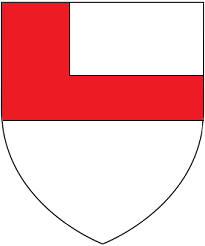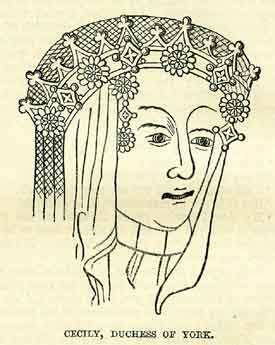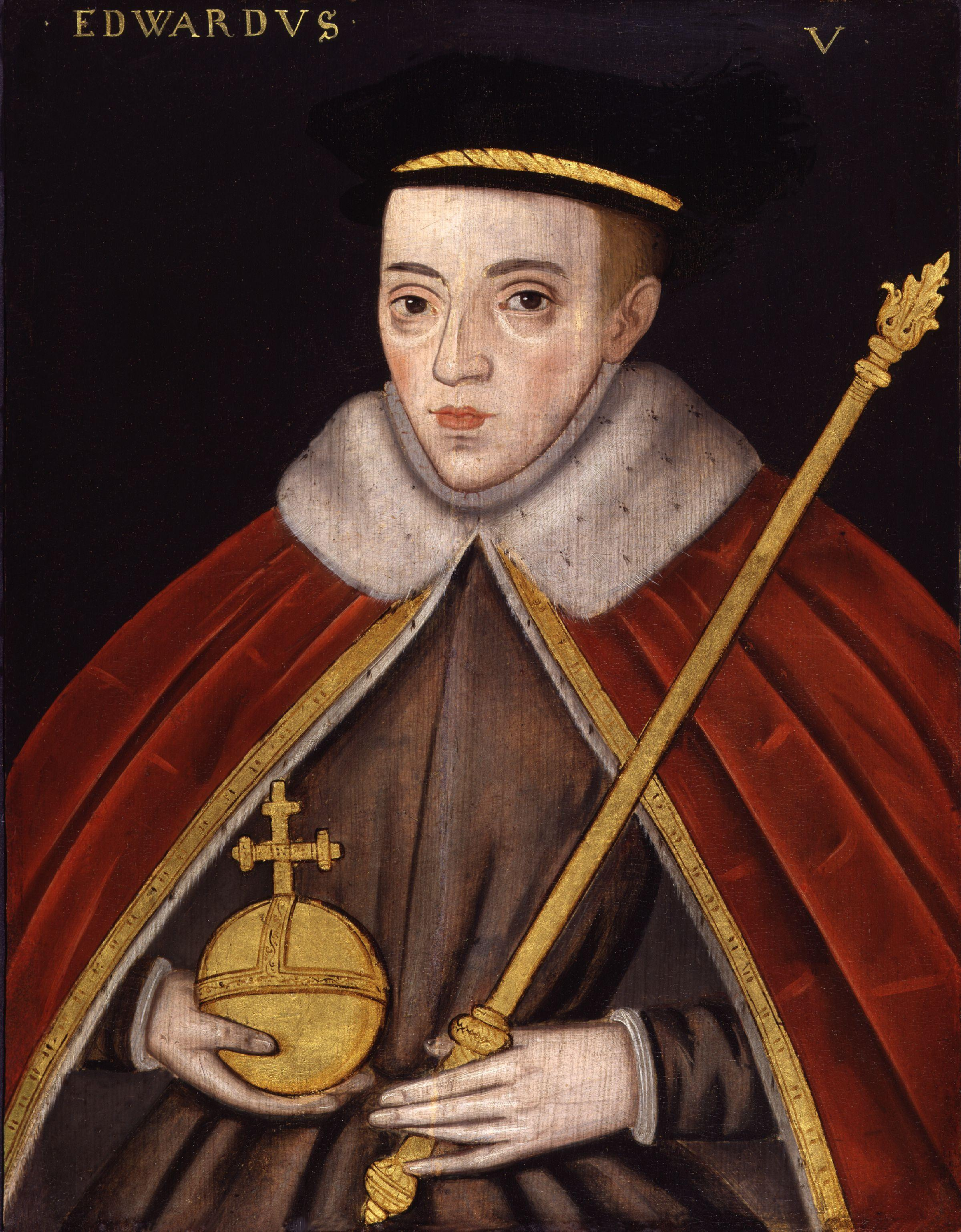|
Bridget Of York
Bridget of York (10 November 1480 – before December 1507), was the seventh daughter of King Edward IV and his queen consort Elizabeth Woodville. Shortly after the death of her father and the usurpation of the throne by Richard III, Bridget, who was not even three years old, was declared illegitimate among the other children of Edward IV by Elizabeth Woodville. The girl's mother, fearing for the lives of the children, moved them to Westminster Abbey, where the family of the late king received asylum and spent about a year. After the king's promise not to harm his brother's family, the elder sisters of the princess went to the court; Bridget, along with another sister Catherine, presumably stayed with her mother. When Richard III died, and Henry Tudor took on the throne under the name of Henry VII, the act recognizing the children of Edward IV as bastards was canceled. Henry VII married Bridget's eldest sister, Elizabeth. Bridget was considered as a possible bride of a Sco ... [...More Info...] [...Related Items...] OR: [Wikipedia] [Google] [Baidu] |
House Of York
The House of York was a cadet branch of the English royal House of Plantagenet. Three of its members became kings of England in the late 15th century. The House of York descended in the male line from Edmund of Langley, 1st Duke of York, the fourth surviving son of Edward III. In time, it also represented Edward III's senior line, when an heir of York married the heiress-descendant of Lionel, Duke of Clarence, Edward III's second surviving son. It is based on these descents that they claimed the English crown. Compared with its rival, the House of Lancaster, it had a superior claim to the throne of England according to cognatic primogeniture, but an inferior claim according to agnatic primogeniture. The reign of this dynasty ended with the death of Richard III of England at the Battle of Bosworth Field in 1485. It became extinct in the male line with the death of Edward Plantagenet, 17th Earl of Warwick, in 1499. Descent from Edward III Edmund of Langley, 1s ... [...More Info...] [...Related Items...] OR: [Wikipedia] [Google] [Baidu] |
Cecily Of York
Cecily of York (20 March 1469 – 24 August 1507), was the third daughter of King Edward IV of England and his queen consort Elizabeth Woodville. Shortly after the death of her father and the usurpation of the throne by her uncle King Richard III, Cecily and her siblings were declared illegitimate. Queen Elizabeth, fearing for the children's lives, moved them to Westminster Abbey, where the late king's family received asylum and spent about a year. After Richard III promised not to harm the children, Cecily and her sisters went to court. Soon there were rumours that the king was going to marry one of his nieces – Elizabeth or Cecily. However, shortly before his death, Richard III arranged the marriage of Cecily to one of his supporters – Ralph Scrope, the younger brother of the 6th Baron Scrope of Masham, who was much lower in status by birth than the princess. When Richard III died at the Battle of Bosworth and the throne was taken by Henry Tudor, the act recognising the ... [...More Info...] [...Related Items...] OR: [Wikipedia] [Google] [Baidu] |
Richard Woodville, 1st Earl Rivers
Richard Woodville, 1st Earl Rivers (1405 – 12 August 1469), also Wydeville, was the father of Elizabeth Woodville and father-in-law of Edward IV. Early life Born at Maidstone in Kent, Richard Woodville was the son of Richard Wydeville (Woodville), chamberlain to the Duke of Bedford, and Joan Bittlesgate (or Bedlisgate), the daughter of Thomas Bittlesgate of Knightstone"Woodville Family", http://www.tudorplace.com.ar/WOODVILLE.htm. Accessed on 10-4-2015. in the parish of Ottery St Mary in Devon. He was also a grandson of John Wydeville who was Sheriff of Northamptonshire (in 1380, 1385, 1390). Marriage and courtly career Woodville followed his father into service with the Duke of Bedford. In 1433 the Duke had married the 17-year-old Jacquetta of Luxembourg; she was the Duke's second wife and he was significantly older and in ill health. When the Duke died in 1435, Jacquetta was left a childless and wealthy widow. She was required to seek permission from King Henry VI ... [...More Info...] [...Related Items...] OR: [Wikipedia] [Google] [Baidu] |
Cecily Neville, Duchess Of York
Cecily Neville (3 May 1415 – 31 May 1495) was an English noblewoman, the wife of Richard, Duke of York (1411–1460), and the mother of two kings of England— Edward IV and Richard III. Cecily Neville was known as "the Rose of Raby", because she was born at Raby Castle in Durham, and "Proud Cis", because of her pride and a temper that went with it, although she was also known for her piety. She herself signed her name "Cecylle". Her husband, the Duke of York, was the leading contender for the throne of England from the House of York during the period of the Wars of the Roses until his death in 1460. Their son Edward actually assumed the throne as Edward IV in 1461, after the deposition of King Henry VI of the House of Lancaster. The Duchess of York thus narrowly missed becoming queen consort of England. Family Cecily Neville was the youngest of the 22 children of Ralph Neville, 1st Earl of Westmorland, in this case born to his second wife Joan Beaufort, Countess of ... [...More Info...] [...Related Items...] OR: [Wikipedia] [Google] [Baidu] |
Richard Of York, 3rd Duke Of York
Richard of York, 3rd Duke of York (21 September 1411 – 30 December 1460), also named Richard Plantagenet, was a leading English magnate and claimant to the throne during the Wars of the Roses. He was a member of the ruling House of Plantagenet by virtue of being a direct male-line descendant of Edmund of Langley, King Edward III's fourth surviving son. However, it was through his mother, Anne Mortimer, a descendant of Edward III's second surviving son, Lionel of Antwerp, that Richard inherited his strongest claim to the throne, as the opposing House of Lancaster was descended from John of Gaunt, Duke of Lancaster, the third surviving son of Edward III. He also inherited vast estates and served in various offices of state in Ireland, France and England, a country he ultimately governed as Lord Protector during the madness of King Henry VI. His conflicts with Henry's wife, Margaret of Anjou, and other members of Henry's court, as well as his competing claim to the throne, w ... [...More Info...] [...Related Items...] OR: [Wikipedia] [Google] [Baidu] |
Princes In The Tower
The Princes in the Tower refers to the apparent murder in England in the 1480s of the deposed King Edward V of England and Richard of Shrewsbury, Duke of York. These two brothers were the only sons of King Edward IV and Elizabeth Woodville surviving at the time of their father's death in 1483. When they were 12 and 9 years old, respectively, they were lodged in the Tower of London by their paternal uncle and all-powerful regent the Duke of Gloucester. This was supposedly in preparation for Edward V's forthcoming coronation. However, before the young king could be crowned, he and his brother were declared illegitimate. Gloucester ascended the throne as Richard III.Tim Thornton"More on a Murder: The Deaths of the ‘Princes in the Tower’, and Historiographical Implications for the Regimes of Henry VII and Henry VIII."''History'' 106.369 (2021): 4-25. It is unclear what happened to the boys after the last recorded sighting of them in the tower. It is generally assumed that they ... [...More Info...] [...Related Items...] OR: [Wikipedia] [Google] [Baidu] |
Richard Of Shrewsbury, Duke Of York
Richard is a male given name. It originates, via Old French, from Old Frankish and is a compound of the words descending from Proto-Germanic ''*rīk-'' 'ruler, leader, king' and ''*hardu-'' 'strong, brave, hardy', and it therefore means 'strong in rule'. Nicknames include "Richie", "Dick", "Dickon", " Dickie", "Rich", "Rick", "Rico", " Ricky", and more. Richard is a common English, German and French male name. It's also used in many more languages, particularly Germanic, such as Norwegian, Danish, Swedish, Icelandic, and Dutch, as well as other languages including Irish, Scottish, Welsh and Finnish. Richard is cognate with variants of the name in other European languages, such as the Swedish "Rickard", the Catalan "Ricard" and the Italian "Riccardo", among others (see comprehensive variant list below). People named Richard Multiple people with the same name * Richard Andersen (other) * Richard Anderson (other) * Richard Cartwright (other) * R ... [...More Info...] [...Related Items...] OR: [Wikipedia] [Google] [Baidu] |
Edward V Of England
Edward V (2 November 1470 – mid-1483)R. F. Walker, "Princes in the Tower", in S. H. Steinberg et al, ''A New Dictionary of British History'', St. Martin's Press, New York, 1963, p. 286. was ''de jure'' King of England and Lord of Ireland from 9 April to 25 June 1483. He succeeded his father, Edward IV, upon the latter's death. Edward V was never crowned, and his brief reign was dominated by the influence of his uncle and Lord Protector, the Duke of Gloucester, who deposed him to reign as King Richard III; this was confirmed by the Act entitled '' Titulus Regius'', which denounced any further claims through his father's heirs. Edward V and his younger brother Richard of Shrewsbury, Duke of York, were the Princes in the Tower who disappeared after being sent to heavily guarded royal lodgings in the Tower of London. Responsibility for their deaths is widely attributed to Richard III, but the lack of solid evidence and conflicting contemporary accounts allow for other possibil ... [...More Info...] [...Related Items...] OR: [Wikipedia] [Google] [Baidu] |
George Plantagenet, Duke Of Bedford
George of York, Duke of Bedford (March 1477 – March 1479) was the eighth child and third son of Edward IV of England and Elizabeth Woodville. George was born in Windsor Castle in March 1477, and was created Duke of Bedford in infancy, probably in 1478, after the former holder of the title, George Neville, was deprived of the title by act of Parliament, ostensibly for lack of money to maintain the style of a duke. He was appointed the Lord Lieutenant of Ireland in 1478, one of a series of nominal and largely absent lieutenants. George died aged two. This is considered likely to have been due to an outbreak of bubonic plague. He was buried in St George's Chapel at Windsor Castle St George's Chapel at Windsor Castle in England is a castle chapel built in the late-medieval Perpendicular Gothic style. It is both a Royal Peculiar (a church under the direct jurisdiction of the monarch) and the Chapel of the Order of the Gart ... on 22 March 1479. Notes References * pages ... [...More Info...] [...Related Items...] OR: [Wikipedia] [Google] [Baidu] |
Richard Grey
Sir Richard Grey (1457 – 25 June 1483) was an English knight and the half-brother of King Edward V of England. Early life Richard Grey was the younger son of Sir John Grey of Groby and Elizabeth Woodville. Richard was a 3-year-old child when his father was killed fighting for the House of Lancaster at the Second Battle of St Albans on 17 February 1461. When Richard was 6 his mother married the Yorkist king, Edward IV, in secret, on 1 May 1464. Richard first appeared on the public scene when he took part in the jousts to celebrate the creation of his half-brother Richard as Duke of York in 1474, a feat he repeated at the 4-year old Duke's marriage celebrations in 1478 to the 5-year old Anne de Mowbray. Knighthood Grey was knighted in 1475 and was nominated four times to membership of The Most Noble Order of the Garter between 1476 and 1482. His political role also started in 1475, the year he was knighted, when he began to serve in Wales and the bordering English countie ... [...More Info...] [...Related Items...] OR: [Wikipedia] [Google] [Baidu] |
Thomas Grey, 1st Marquess Of Dorset
Thomas Grey, 1st Marquess of Dorset, 1st Earl of Huntingdon, 7th Baron Ferrers of Groby, (145520 September 1501) was an English nobleman, courtier and the eldest son of Elizabeth Woodville and her first husband Sir John Grey of Groby. Her second marriage to King Edward IV made her Queen of England, thus elevating Grey's status at court and in the realm as the stepson of the King. Through his mother's assiduous endeavours, he made two materially advantageous marriages to wealthy heiresses, the King's niece Anne Holland and Cecily Bonville, 7th Baroness Harington. By the latter, he had 14 children. Family Thomas Grey was born in 1455 close to the Palace of Westminster, near the City of London. He was the elder son of John Grey (c.1432-1461) of Groby in Leicestershire, by his wife Elizabeth Woodville, who later became queen consort to King Edward IV. Career His mother endeavoured to improve his estates by the conventional methods of their class and time, through his marriages a ... [...More Info...] [...Related Items...] OR: [Wikipedia] [Google] [Baidu] |
John Grey Of Groby
Sir John Grey, of Groby, Leicestershire (c. 1432Douglas Richardson. ''Plantagenet Ancestry: A Study In Colonial And Medieval Families,'' 2nd Edition, 2011. pg 161-164. – 17 February 1461) was a Lancastrian knight, the first husband of Elizabeth Woodville who later married King Edward IV of England, and great-great-grandfather of Lady Jane Grey. Titles Grey was the son and heir of Elizabeth Ferrers, 6th Baroness Ferrers of Groby (1419–1483) and of Sir Edward Grey (c. 1415–1457), a son of Reginald Grey, 3rd Baron Grey de Ruthyn. His father was summoned to parliament as Baron Ferrers of Groby in right of his wife.Douglas Richardson & Kimball G. Everingham, ''Plantagenet Ancestry: A Study in Colonial and Medieval Families'', p. 359 After the death of Grey's father in 1457, his mother married his stepfather, John Bourchier, in 1462; he assumed his wife's title, Baron Ferrers of Groby. As Grey predeceased his mother, Lady Ferrers, the title of Baron Ferrers of Groby passe ... [...More Info...] [...Related Items...] OR: [Wikipedia] [Google] [Baidu] |
.jpg)




